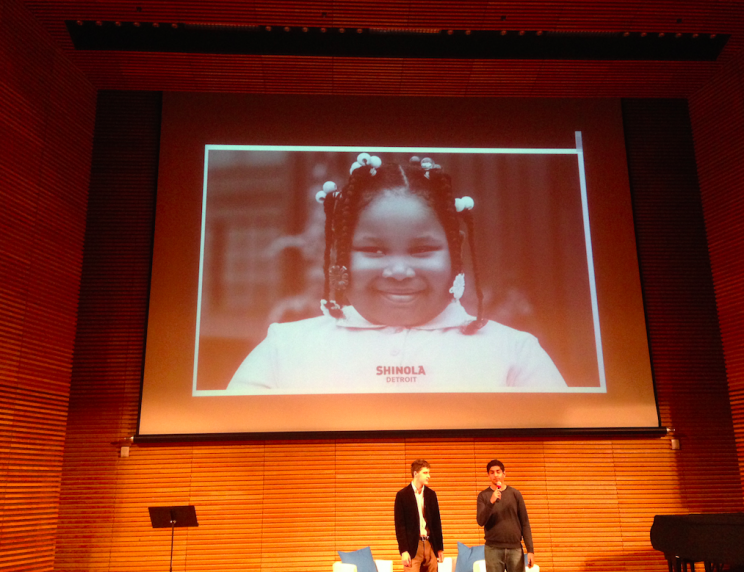Using art to shine light on Shinola

You may have heard of Shinola, the racist shoe-polish company of the early 20th century whose brand was reinvented by hypercapitalists from Texas into the feel-good story of Detroit, marketing $1,100 watches and bicycles for more than what many Detroiters would pay for a car.
Shinola’s marketing might make rich white folk feel like they’re “saving” Detroit by purchasing one of those incredibly overpriced, made in China/assembled in the USA by poor black people, pieces. But what the company is really doing is reinforcing a racist, plantation mentality, and selling it to the world like they are martyrs saving Detroit with each and every watch that bears its name.
But, if you’re not media and history savvy, you probably don’t know that. Enter Rebekah Modrak, an artist and professor at University of Michigan’s Stamps School of Art & Design.
Modrak’s jam is brand critique and critiquing the messaging brands put out. Photography is an expression of power, she says. So rather than taking new photos, much of her work is commenting on existing images and reenacting old, exploitative ones so the general public can see just how archaic and harmful the images—or in Shinola’s case, the brand—really are.
Modrak’s website, RethinkShinola, tears apart the brand and the founder Jacques Panis’s belief that “There’s such a wonderful history and heritage to the name Shinola. It’s a very iconic brand in the United States,” when, in fact, its heritage of branding was, and continues to be, racist.
Modrak was inspired to take action after seeing Shinola’s collaboration with the College for Creative Studies in Detroit. She was disturbed by her observations of what happens when “we start communicating to students that Shinola’s practices are good for the city” and by “the lack of critical thinking and facilitating Shinola’s business.”
Watching founder Panis speak at the University of Michigan’s Center for Entrepreneurship, in a lecture the university has since refused to post (though Modrak says they have posted all other lectures in the series), bothered her. The images, propaganda, and words he used were all about “whites rescuing Detroit.” African Americans were “always in uniform,” while the “white designers were in regular clothes. It was racist in how they were portraying people in Detroit.”
So, though it isn’t surprising U-M won’t be posting such an un-PC lecture, Modrak decided to recreate the entire lecture on her own, down to the “ums” and pauses, and hired an actor to deliver it, so the public could see just what Shinola really is all about
She also re-created a Shinola promotional video, using animation and breaking it down in a way that makes the colonialism and the implicit racism hard to ignore.
“Shinola presents itself as a job creator as a shield,” Modrak says. “Most of [the] criticism of [my] project comes from that.”
Yet the idea of the importance of job creation is really an idea often used to distract people from larger systems of power—in this case, Shinola’s perpetuation of the colonialism mentality and imposing it upon Detroit, a city where over 80 percent of the population is African American. The jobs argument, she writes on her RethinkShinola site, “fail[s] to consider the profound price of marketing blackness and appropriating the cultural history of Detroit. African Americans were brought to the United States as slaves for ‘jobs,’ and the narrative of ‘being fortunate to have wage labor’ has continued since then.”
“People should be more critical of what they’re consuming,” she says, especially “brand messaging. People need to be critical of these brand narratives.”
Shinola, she writes in her artist statement, “devalues African Americans and advances whiteness within sophisticated graphic design and brand marketing; the assumption of superiority, of dominance and subordination, playing out elegantly within everyday interactions and messages. RETHINK SHINOLA. Detroiters should control the word ‘Detroit.’ African Americans should control their own representations and should define and control resources to build ‘community.’”
While there is a ton of useful, eye-opening information on the site—including Shinola’s racist ads, exploitative remarks made by CEO Jacques Panis, and more—there isn’t a lot of humor in Modrak’s Shinola piece.
But there is a lot of humor in her media attacking Best Made Company—a luxury ax company—where you can buy an ax designed in New York City for just $348.
The website Modrak created, RemadeCo, replaces the ax for a luxury plunger. “Repeating the same words back until it’s annoying… using their words and shifting them slightly so the problems shine through,” is her tactic, and the point is made, hilariously, as you scroll through her website, looking at luxury plungers.
Modrak is in mild awe of the Best Made Company’s Facebook page (and, it seems, brand deification in general), where people will post things like “I’m drinking out of your blue enamel cup.”
“I don’t get that,” she says. “Seeking approval from a brand? Why would someone want to be patted on the head by this company?”
She urges consumers to “Stop buying colonialist versions of Detroit and blackness. Do not buy Shinola products.”
And maybe consider that brands aren’t human, and that a luxury ax isn’t going to magically turn you into a rugged woodsman any more than drinking out of a blue enamel cup will.
But until our shared society has a collective epiphany, and as long as brands continue to tell ridiculous, slick stories, Modrak will continue to question, and produce art that makes it hard to look away or to deny what the true message behind the brand is.
See more of Rebekah Modrak’s work at rebekahmodrak.com
This piece was posted at AlterNet. Thank you for reading it. Please consider sharing it and making a gift in support of my work.
Thank you.

You must be logged in to post a comment.